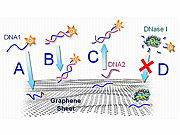- Number 314 |
- June 21, 2010
Graphene and DNA team up to sense trouble

An illustration of how
fluorescent-tagged DNA
interacts with functionalized
graphene. Both single-stranded
DNA (A) and double-stranded
DNA (B) are adsorbed onto a
graphene surface, but the
interaction is stronger with
ssDNA, causing the
fluorescence on the ssDNA
to darken more. C)
A complementary DNA nears
the ssDNA and causes the
adsorbed ssDNA to detach
from the graphene surface.
D) DNA adsorbed onto
graphene is protected from
being broken down.
Just as in formulaic geek-tough guy buddy movies, nobody was convinced that delicate single-stranded DNA could work with graphene, a tough nanomaterial made of sheets of carbon atoms. However, scientists at DOE’s Pacific Northwest National Laboratory and Princeton University believed the two would make a great team for detecting diseases using blood, saliva, and other biological fluids. And, just like in the movies, DNA and graphene really get the job done. Through a series of studies at DOE’s EMSL, the team found that the single-stranded DNA picks out biomolecules that indicate disease with a high degree of specificity. The graphene protects the DNA from being broken down by enzymes while it works. This research could lead to stable biosensors that are more accurate than conventional sensors and for application in gene therapy. PNNL's Transformational Materials Science Initiative funded this study.
[Kristin Manke, 509.372.6011,
kristin.manke@pnl.gov]
